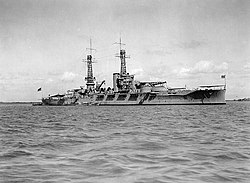USS Oklahoma (BB-37)
|
The Oklahoma in 1920
|
||||||||||||||||
|
||||||||||||||||
|
||||||||||||||||
|
||||||||||||||||
|
||||||||||||||||
The USS Oklahoma (BB-37), a battleship of the Nevada class was so far the only ship of the US Navy , which according to Oklahoma , the 46th state of the United States is named. The keel was laid on October 26, 1912 by New York Shipbuilding in Camden , New Jersey . The launch took place on March 23, 1914, after the ship had been christened by Miss Lorena J. Cruce. On May 2, 1916, the ship entered service in Philadelphia , Pennsylvania , under the command of Captain Roger Welles.
After being assigned to the Atlantic Fleet , the Oklahoma was given a home port in Norfolk , Virginia . With her sister ship Nevada , the ship trained off the east coast of the United States until August 13, 1918 in order to be prepared for its task of protecting Allied convoys in European waters. In December, she was part of the escort for US President Woodrow Wilson on his arrival in France . On December 14, she sailed for New York City and later took part in the fleet's winter exercises in Cuban waters. She returned to Brest on June 15, 1919 to once again accompany President Wilson - on board the George Washington transporter - after completing his second trip to France. On July 8th they reached New York.
From December 6, 1940, Pearl Harbor was the home base for all patrols and exercises. On the day of the attack on Pearl Harbor , the Oklahoma was anchored in Battleship Row . There she lay on the outside alongside the Maryland . Immediately after the attack began, she was hit by three torpedoes on her port side . When they already heavy list , had two more torpedoes slammed into the upper deck and superstructure. After twenty minutes the ship had turned on its side and only the starboard side of the hull was sticking out of the water. Some of the survivors climbed aboard the Maryland and supported the crews of the anti-aircraft guns . Twenty officers and 395 non-commissioned officers and men were killed in the sinking or went missing. The 20-year-old Seaman First Class James Richard Ward refused to leave the ship and rescued several comrades from inside the ship, but he was killed himself. He was later honored with the Medal of Honor , the highest honor of the US armed forces, and the Navy named the destroyer J. Richard Ward , which was commissioned in 1943, after him.
Recovery of the wreck began in March 1943 and was difficult as it had to be erected first. On December 28, 1943, the Oklahoma could be towed into dry dock. The superstructures had previously been removed. On September 1, 1944, the ship was finally abandoned and sold as scrap on December 5, 1946. While being towed to the designated scrapping site in San Francisco , she broke loose on May 17, 1947 and sank 540 nautical miles from Pearl Harbor .
The Oklahoma received a Service Star for service in World War II .

